Simulation of Surface Topography Considering Cut-in Impact and Tool Flank Wear
Abstract
1. Introduction
2. The Kinematic Trajectory Equation of Cutting Edges
3. Milling Dynamics Equation
4. Mathematical Model of Impact Force
4.1. The Normal Contact Force Model
4.2. The Tangential Contact Force Model
5. The Simulation Arithmetic of Surface Topography
6. Experimental Set-Up
6.1. Experimental Equipment
6.2. Experimental Analysis
7. Results
8. Conclusions
- The simulated surface texture and roughness are in good agreement with the experimental measurements, which verifies the correctness of the surface morphology prediction model. The reasons for the difference in surface morphology between the simulated and experimental are as follows: (1) the cut-in phase angle is random in the experiment process; (2) the surface topography model does not take into account the tool deformation; (3) the tool wear is assumed to be the same in the wear area in the simulation process.
- The prediction model of surface topography considering cut-in impact has higher accuracy, and the error of surface roughness is reduced from 12.09% to 9.52%.
- With the increase of tool wear, the texture structure of the workpiece surface changes and the maximum scallop height on the surface increases accordingly. Meanwhile, the texture asperities grow and the grooves deepen with tool wear in the experiments. The worn tool causes scratches on the machined surface, which leads to deterioration of the machined surface.
- The surface roughness increases with the increase of tool wear. However, the growth rate of surface roughness has a nonlinear relationship with tool wear. When the tool wear is less than 0.164 mm, the surface roughness simulation results are in good agreement with the experimental results. When the tool wear is 0.21 mm, the maximum error between the surface roughness simulation and the experimental measurement is 21.9%. The reason is that the cutting edge near the tool tip induces micro-chipping.
Author Contributions
Funding
Conflicts of Interest
References
- Yue, C.; Gao, H.; Liu, X.; Liang, S. Part Functionality Alterations Induced by Changes of Surface Integrity in Metal Milling Process: A Review. Appl. Sci. 2018, 8, 2550. [Google Scholar] [CrossRef]
- M’Saoubi, R.; Outeiro, J.C.; Chandrasekaran, H.; Dillon, O.W., Jr.; Jawahir, I.S. A review of surface integrity in machining and its impact on functional performance and life of machined products. Int. J. Sustain. Manuf. 2008, 1, 203–236. [Google Scholar] [CrossRef]
- Liu, X.; Gao, H.; Yue, C.; Li, R.; Jiang, N.; Yang, L. Investigation of the milling stability based on modified variable cutting force coefficients. Int. J. Adv. Manuf. Technol. 2018, 96, 2991–3002. [Google Scholar] [CrossRef]
- Yue, C.; Liu, X.; Ding, Y.; Liang, S.Y. Off-line error compensation in corner milling process. Proc. Inst. Mech. Eng. Part B J. Eng. Manuf. 2018, 232, 1172–1181. [Google Scholar] [CrossRef]
- Yue, C.; Gao, H.; Liu, X.; Liang, S.Y. A review of chatter vibration research in milling. Chin. J. Aeronaut. 2019, in press. [Google Scholar] [CrossRef]
- Mizugaki, Y.; Hao, M.; Kikkawa, K.; Nakagawa, T. Geometric generating mechanism of machined surface by ball-nosed end milling. CIRP Ann. 2001, 50, 69–72. [Google Scholar] [CrossRef]
- Mizugaki, Y.; Kikkawa, K.; Terai, H.; Hao, M.; Sata, T. Theoretical estimation of machined surface profile based on cutting edge movement and tool orientation in ball-nosed end milling. CIRP Ann. 2003, 52, 49–52. [Google Scholar] [CrossRef]
- Bouzakis, K.D.; Aichouh, P.; Efstathiou, K. Determination of the chip geometry, cutting force and roughness in free form surfaces finishing milling, with ball end tools. Int. J. Mach. Tool Manuf. 2003, 43, 499–514. [Google Scholar] [CrossRef]
- Jung, T.S.; Yang, M.Y.; Lee, K.J. A new approach to analysing machined surfaces by ball-end milling, part I. Int. J. Adv. Manuf. Technol. 2005, 25, 833–840. [Google Scholar] [CrossRef]
- Jung, T.S.; Yang, M.Y.; Lee, K.J. A new approach to analysing machined surfaces by ball-end milling, part II. Int. J. Adv. Manuf. Technol. 2005, 25, 841–849. [Google Scholar] [CrossRef]
- Liu, X.; Soshi, M.; Sahasrabudhe, A.; Yamazaki, K.; Mori, M. A geometrical simulation system of ball end finish milling process and its application for the prediction of surface micro features. J. Manuf. Sci. Eng. 2006, 128, 74–85. [Google Scholar] [CrossRef]
- Buj-Corral, I.; Vivancos-Calvet, J.; Domínguez-Fernández, A. Surface topography in ball-end milling processes as a function of feed per tooth and radial depth of cut. Int. J. Mach. Tool Manuf. 2012, 53, 151–159. [Google Scholar] [CrossRef]
- Xu, J.; Zhang, H.; Sun, Y. Swept surface-based approach to simulating surface topography in ball-end CNC milling. Int. J. Adv. Manuf. Technol. 2017, 98, 1–12. [Google Scholar] [CrossRef]
- Lazoglu, I. 3D surface topography analysis in 5-axis ball-end milling. CIRP Ann. 2017, 66, 133–136. [Google Scholar]
- Bo, L.; Yanlong, C.; Wenhua, C.; Jun, P. Geometry simulation and evaluation of the surface topography in five-axis ball-end milling. Int. J. Adv. Manuf. Technol. 2017, 93, 1651–1667. [Google Scholar] [CrossRef]
- Arizmendi, M.; Campa, F.J.; Fernández, J.; de Lacalle, L.L.; Gil, A.; Bilbao, E.; Veiga, F.; Lamikiz, A. Model for surface topography prediction in peripheral milling considering tool vibration. CIRP Ann. 2009, 58, 93–96. [Google Scholar] [CrossRef]
- Jiang, H.; Long, X.; Meng, G. Study of the correlation between surface generation and cutting vibrations in peripheral milling. J. Mater. Process. Technol. 2008, 208, 229–238. [Google Scholar] [CrossRef]
- Costes, J.P.; Moreau, V. Surface roughness prediction in milling based on tool displacements. J. Manuf. Process. 2011, 13, 133–140. [Google Scholar] [CrossRef]
- Peng, Z.; Jiao, L.; Yan, P.; Yuan, M.; Gao, S.; Yi, J.; Wang, X. Simulation and experimental study on 3D surface topography in micro-ball-end milling. Int. J. Adv. Manuf. Technol. 2018, 96, 1943–1958. [Google Scholar] [CrossRef]
- Chen, W.; Xie, W.; Huo, D.; Yang, K. A novel 3D surface generation model for micro milling based on homogeneous matrix transformation and dynamic regenerative effect. Int. J. Mech. Sci. 2018, 144, 146–157. [Google Scholar] [CrossRef]
- Lu, X.; Hu, X.; Jia, Z.; Liu, M.; Gao, S.; Qu, C.; Liang, S.Y. Model for the prediction of 3D surface topography and surface roughness in micro-milling Inconel 718. Int. J. Adv. Manuf. Technol. 2018, 94, 2043–2056. [Google Scholar] [CrossRef]
- Yang, L.; Wu, S.; Liu, X.; Liu, Z.; Zhu, M.; Li, Z. The effect of characteristics of free-form surface on the machined surface topography in milling of panel mold. Int. J. Adv. Manuf. Technol. 2018, 98, 151–163. [Google Scholar] [CrossRef]
- Zhang, C.; Guo, S.; Zhang, H.; Zhou, L. Modeling and predicting for surface topography considering tool wear in milling process. Int. J. Adv. Manuf. Technol. 2013, 68, 2849–2860. [Google Scholar] [CrossRef]
- Zhang, C.; Zhang, H.; Li, Y.; Zhou, L. Modeling and on-line simulation of surface topography considering tool wear in multi-axis milling process. Int. J. Adv. Manuf. Technol. 2015, 77, 735–749. [Google Scholar] [CrossRef]
- Omar, O.E.; El-Wardany, T.; Ng, E.; Elbestawi, M.A. An improved cutting force and surface topography prediction model in end milling. Int. J. Mach. Tool Manuf. 2007, 47, 1263–1275. [Google Scholar] [CrossRef]
- Liu, C.; Chen, B. A global review dynamic research of flexible multibody for the impact systems. Adv. Mech. 2000, 1, 7–14. [Google Scholar]
- Liu, X.; Gao, H.; Yue, C.; Jiang, N. Research on cutting force modeling and surface quality in the transition area of the mosaic. J. Vib. Meas. Diagn. 2018, 38, 429–437. [Google Scholar]

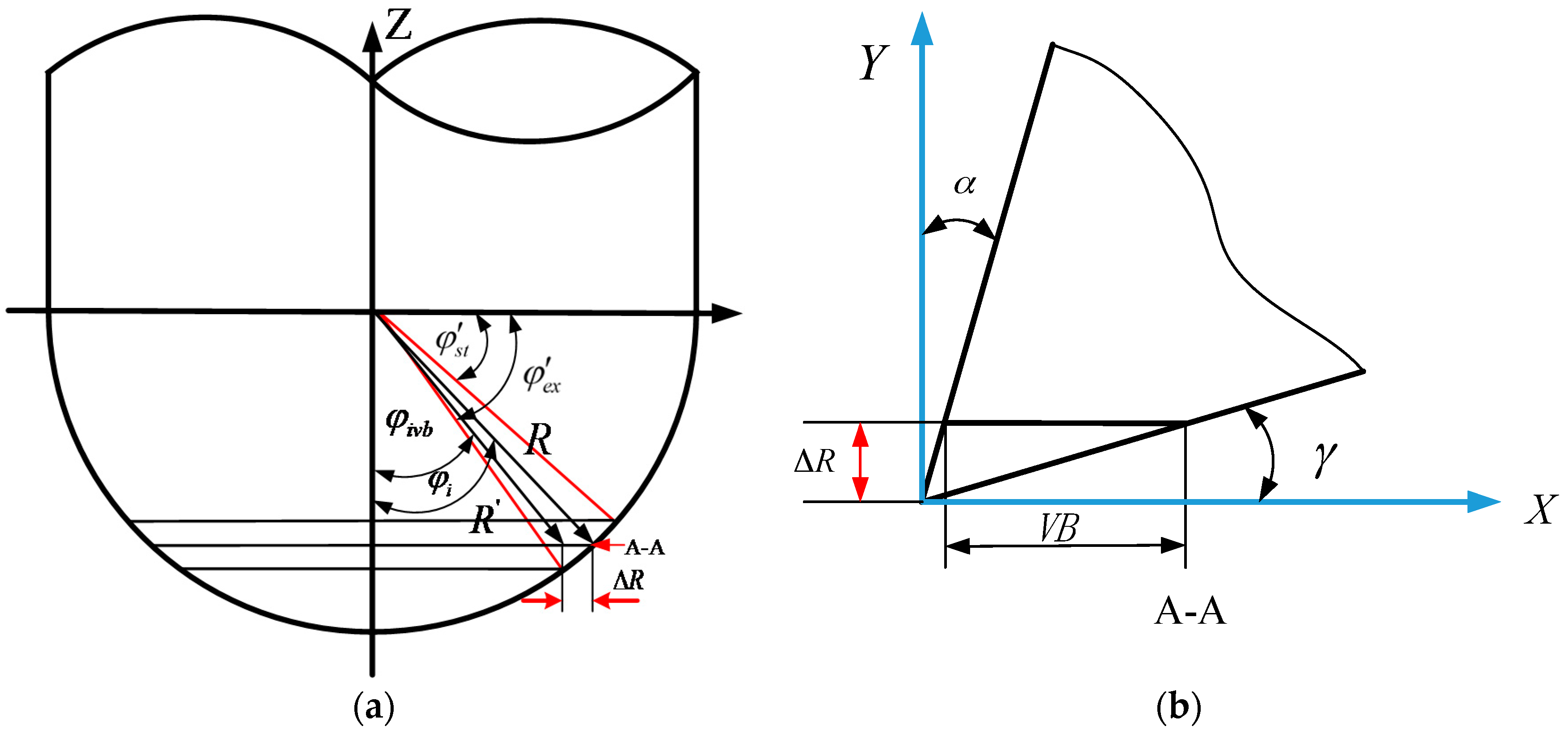
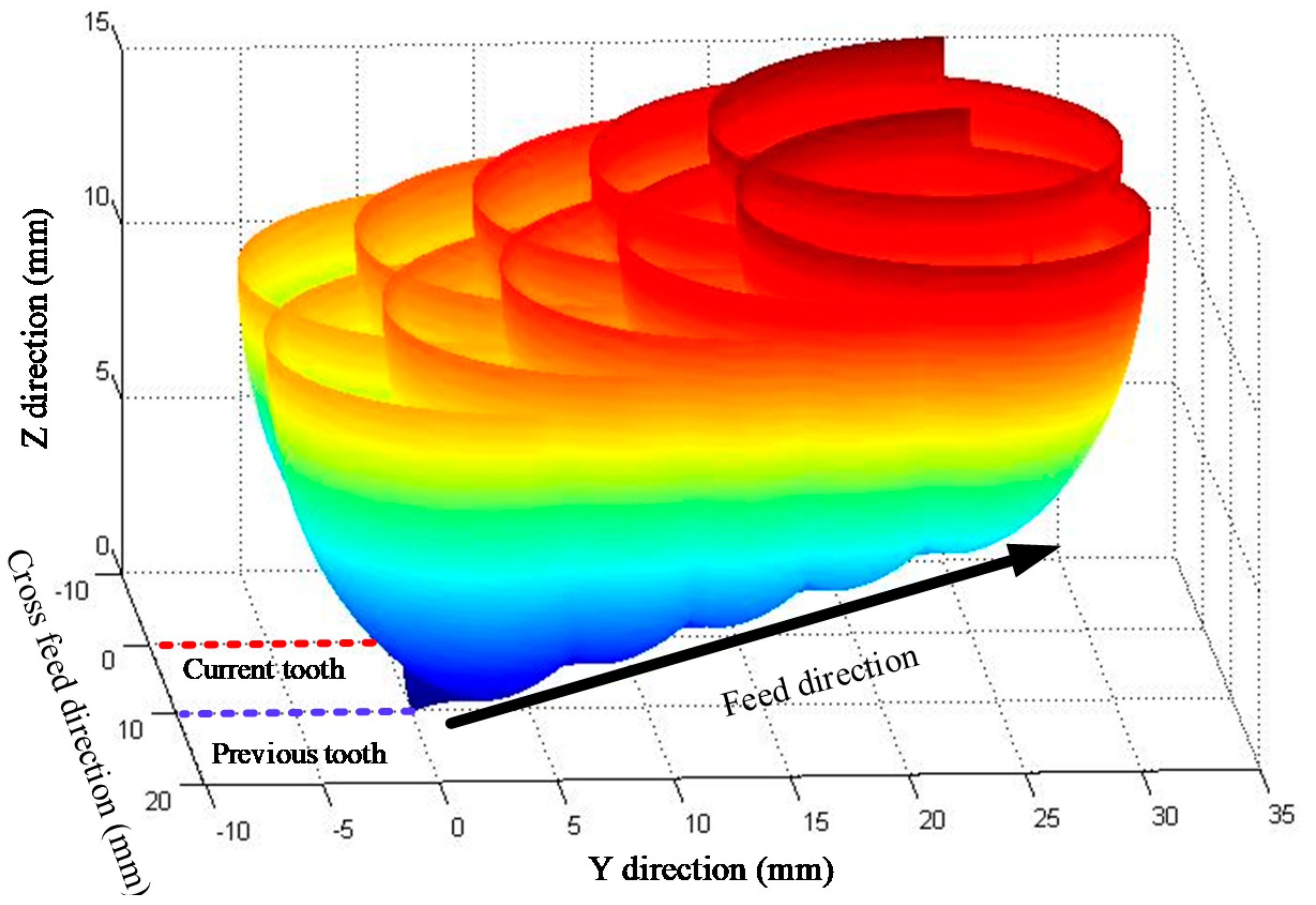

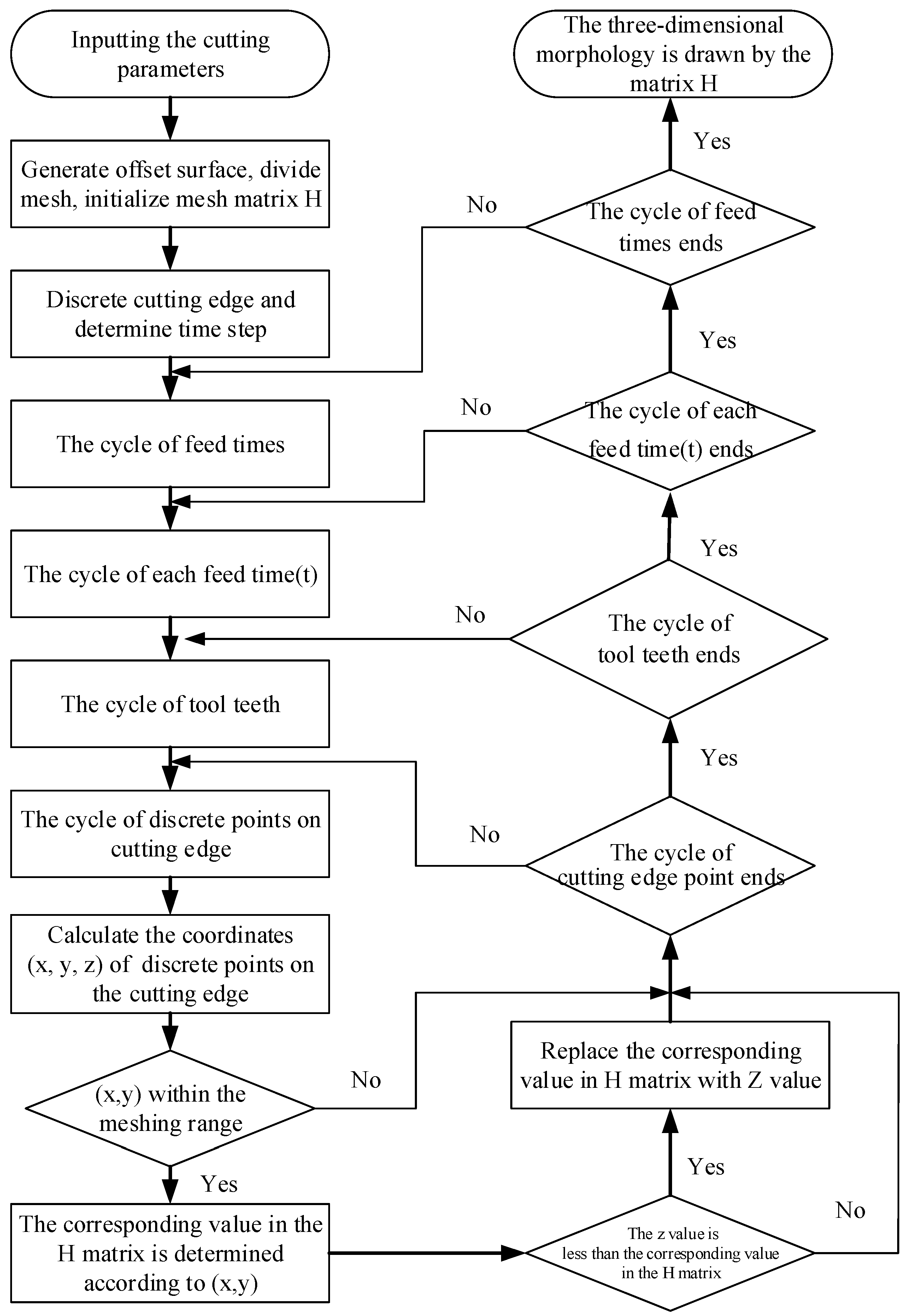
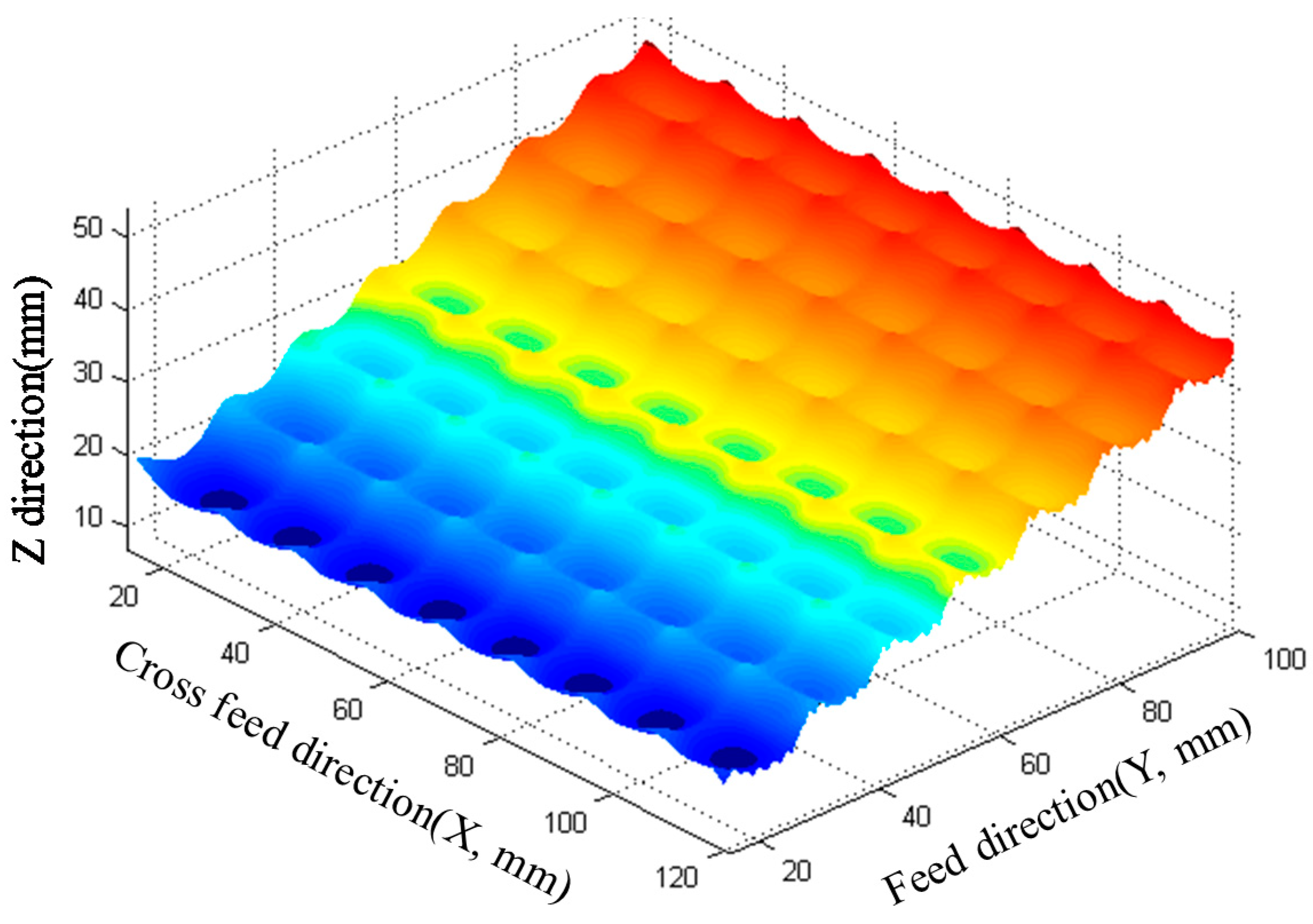
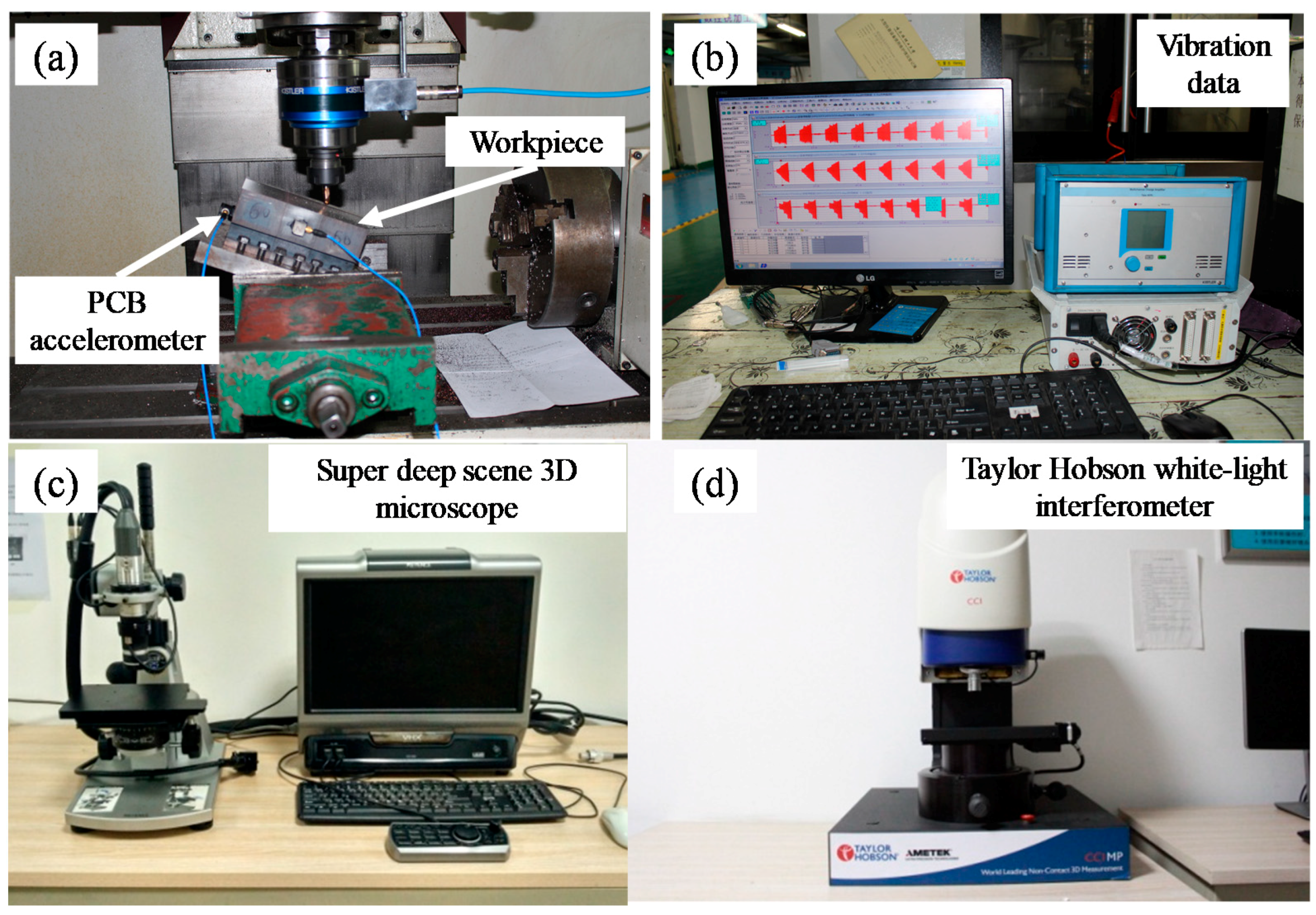

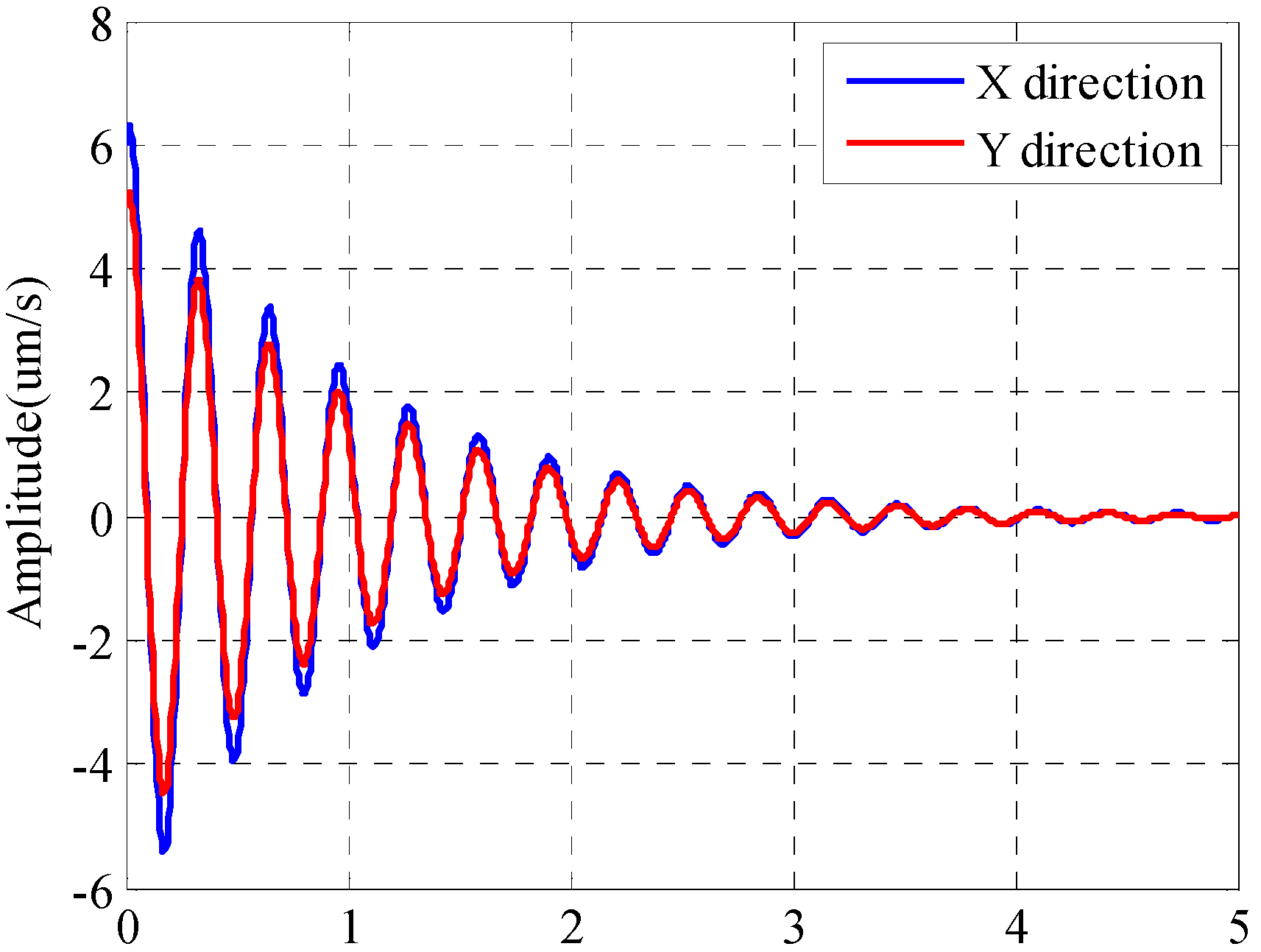
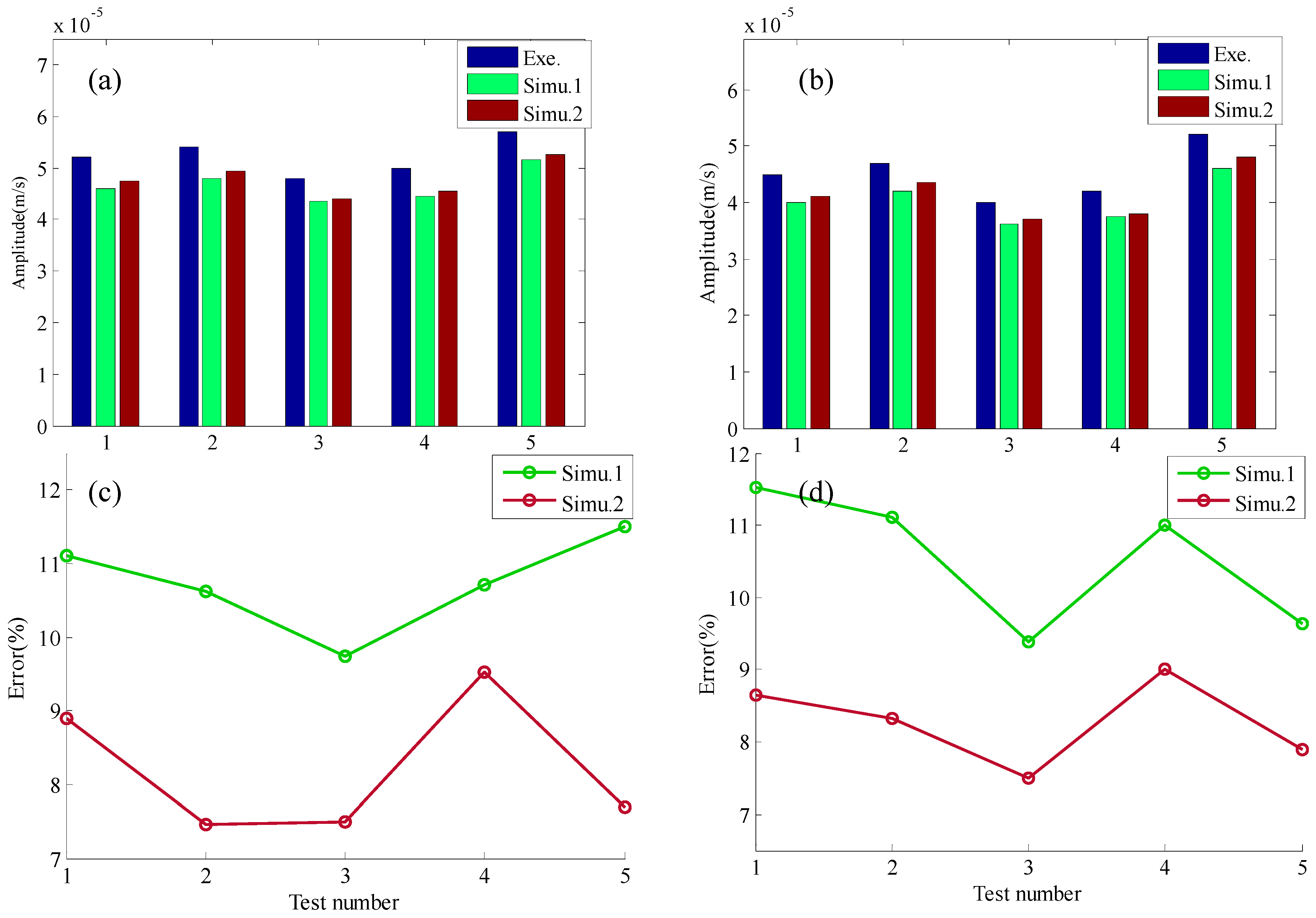

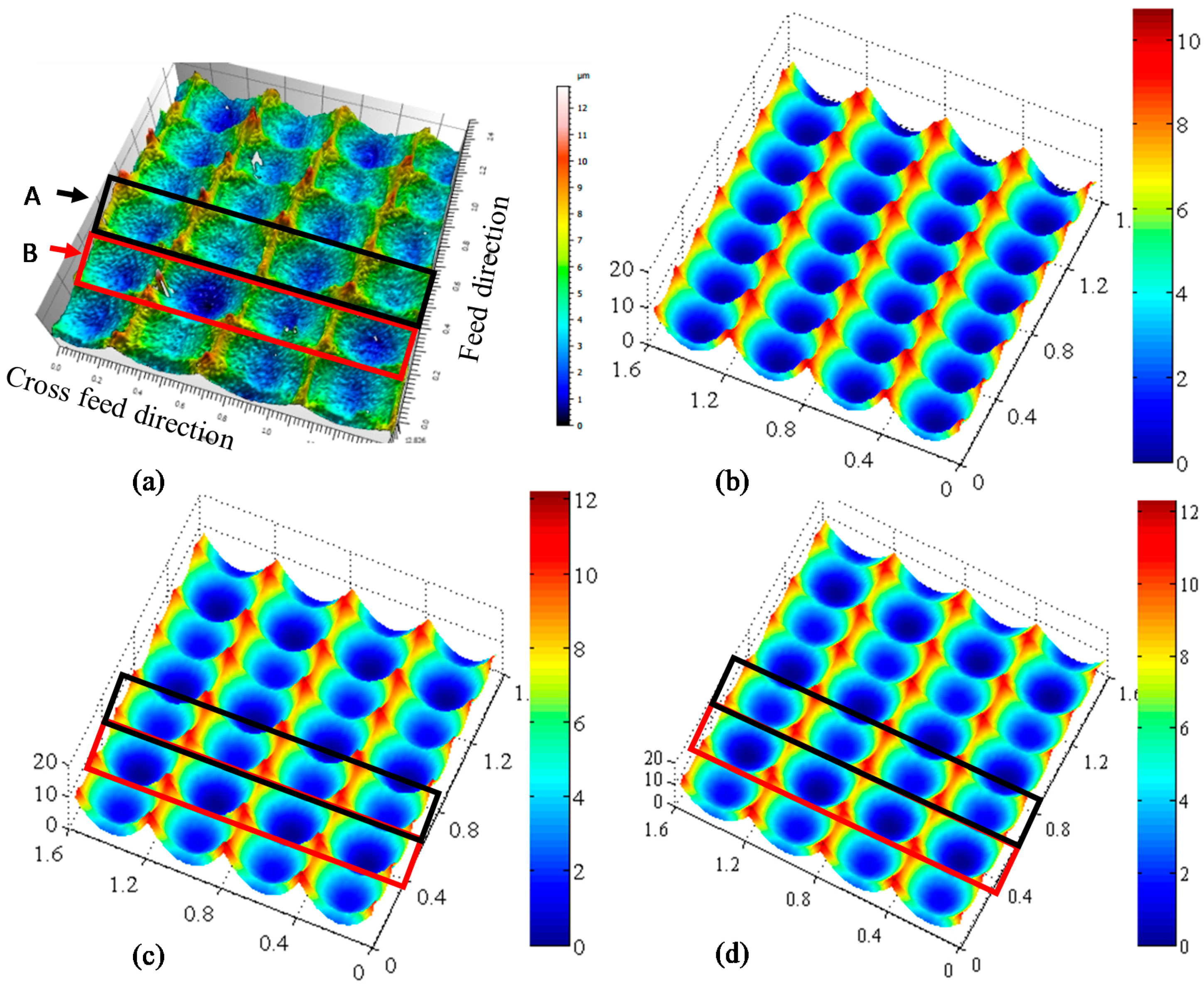
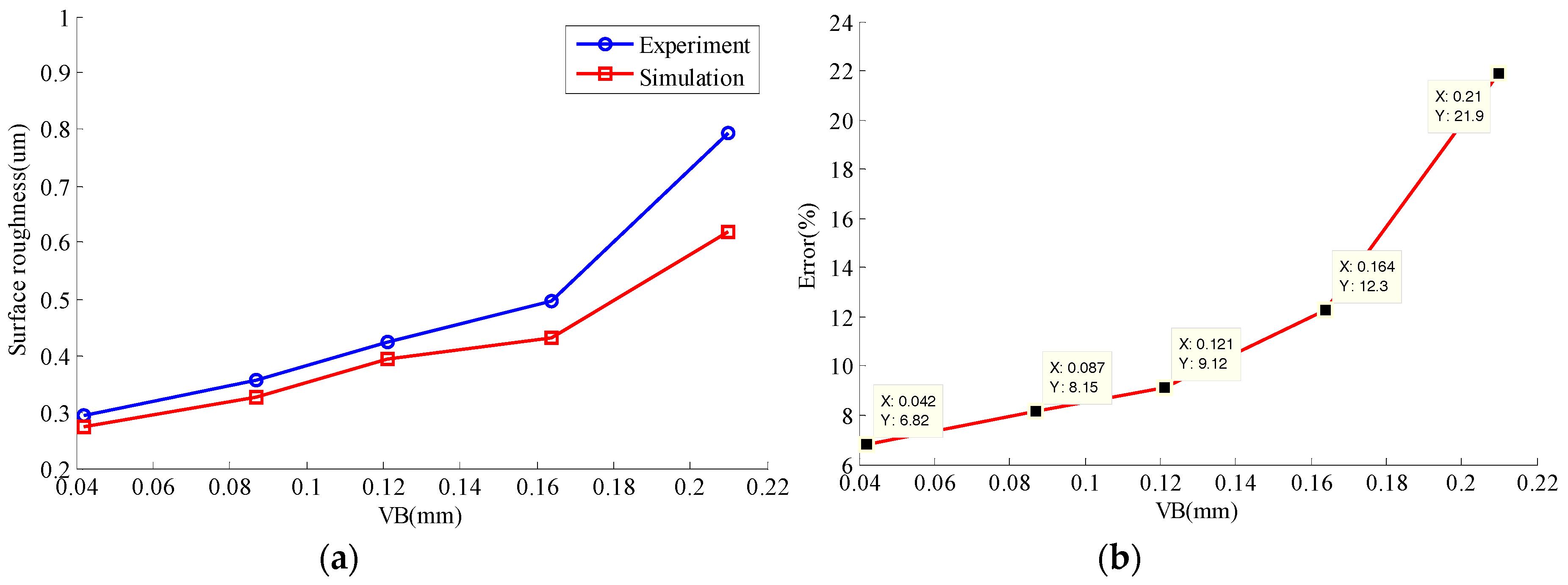
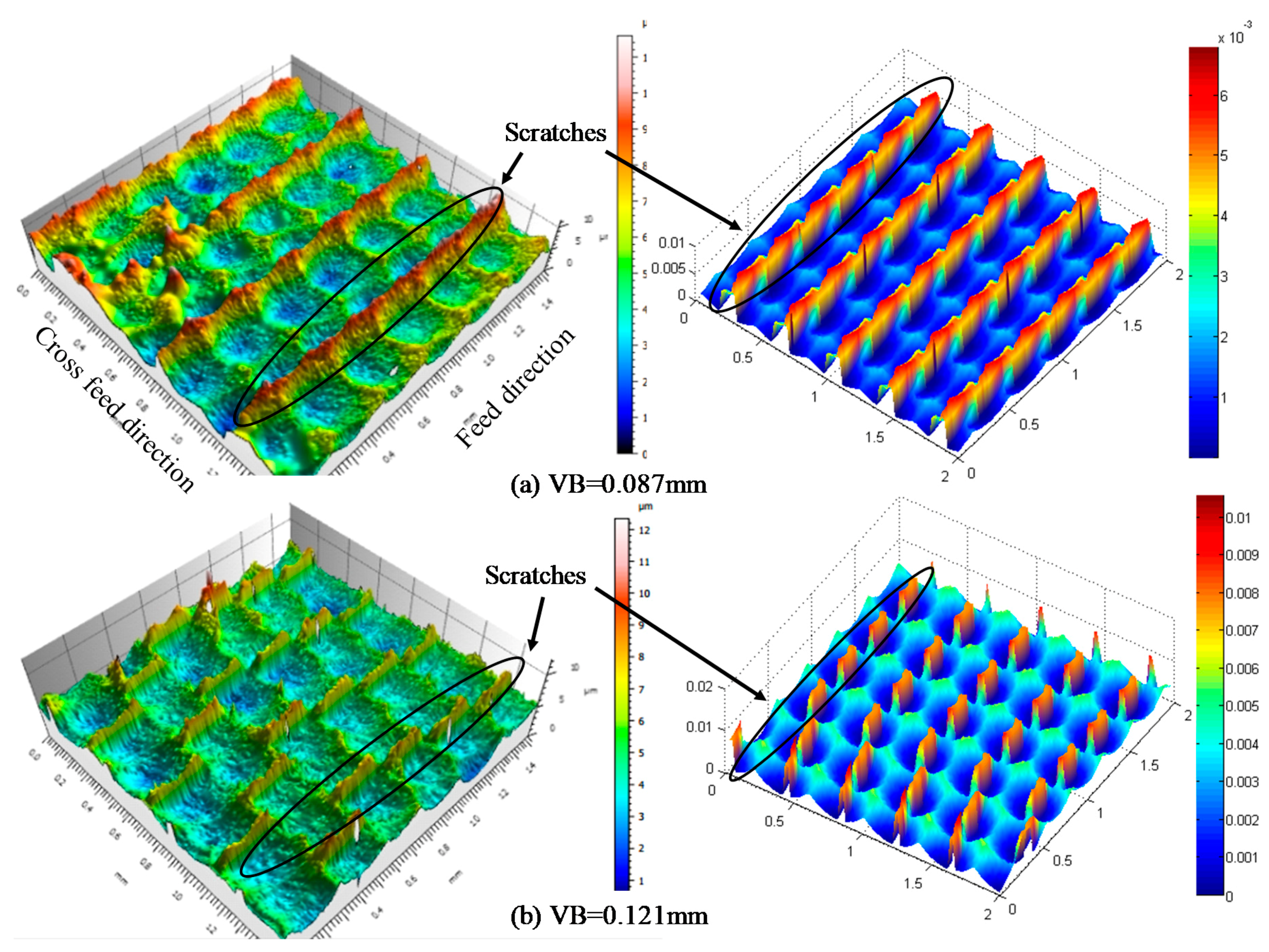
| Test No. | Spindle Speed (r/min) | Cutting Depth (mm) | Cutting Width (mm) | Feed per Tooth (mm/tooth) |
|---|---|---|---|---|
| 1 | 5000 | 0.25 | 0.3 | 0.1 |
| 2 | 5000 | 0.3 | 0.25 | 0.10 |
| 3 | 4000 | 0.25 | 0.2 | 0.12 |
| 4 | 4000 | 0.25 | 0.25 | 0.1 |
| 5 | 4000 | 0.3 | 0.3 | 0.15 |
| Natural Frequency (Hz) | Damping Ratio | Stiffness (N/m) | |
|---|---|---|---|
| x direction | 785 | 0.0246 | 1.74 × 107 |
| y direction | 800 | 0.0263 | 1.71 × 107 |
| Workpiece | Ktc (N/mm2) | Krc (N/mm2) | Kte (N/mm) | Kre (N/mm) |
|---|---|---|---|---|
| Cr12MoV hardened steel | 1842.2 | 1842.2 | 1842.2 | 134.9 |
© 2019 by the authors. Licensee MDPI, Basel, Switzerland. This article is an open access article distributed under the terms and conditions of the Creative Commons Attribution (CC BY) license (http://creativecommons.org/licenses/by/4.0/).
Share and Cite
Gao, H.; Yue, C.; Liu, X.; Nan, Y. Simulation of Surface Topography Considering Cut-in Impact and Tool Flank Wear. Appl. Sci. 2019, 9, 732. https://doi.org/10.3390/app9040732
Gao H, Yue C, Liu X, Nan Y. Simulation of Surface Topography Considering Cut-in Impact and Tool Flank Wear. Applied Sciences. 2019; 9(4):732. https://doi.org/10.3390/app9040732
Chicago/Turabian StyleGao, Haining, Caixu Yue, Xianli Liu, and Yuechong Nan. 2019. "Simulation of Surface Topography Considering Cut-in Impact and Tool Flank Wear" Applied Sciences 9, no. 4: 732. https://doi.org/10.3390/app9040732
APA StyleGao, H., Yue, C., Liu, X., & Nan, Y. (2019). Simulation of Surface Topography Considering Cut-in Impact and Tool Flank Wear. Applied Sciences, 9(4), 732. https://doi.org/10.3390/app9040732





